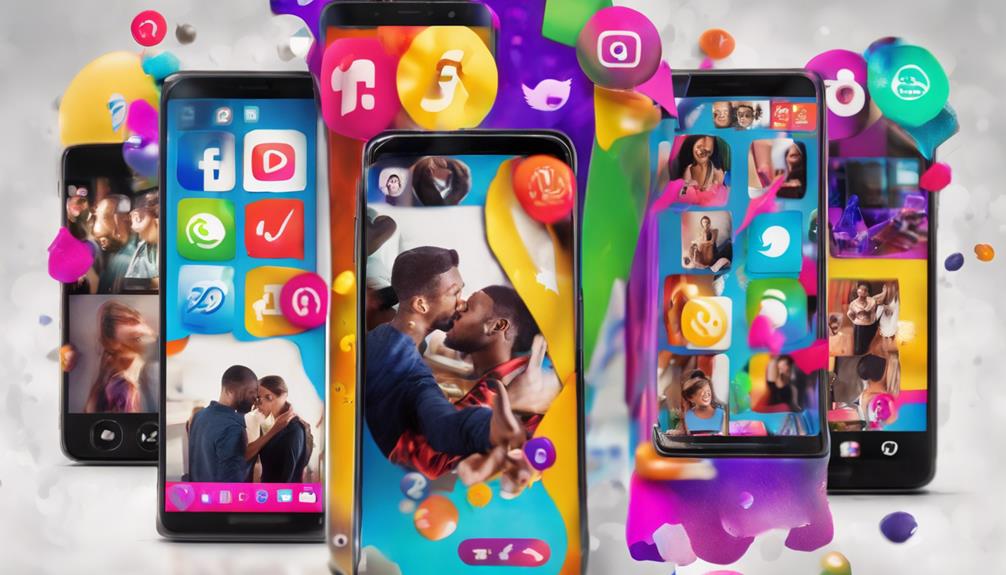Il video verticale sta rivoluzionando il coinvolgimento sui social media adattandosi al modo in cui gli utenti tengono naturalmente i loro smartphone. Con il 57% dei video generati dagli utenti girati in verticale, piattaforme come TikTok e Instagram stanno dando priorità a questo formato per una migliore ritenzione e interazione degli spettatori. I video verticali non solo concentrano l'attenzione sul soggetto principale, ma si adattano anche a span di attenzione più brevi, portando a tassi di coinvolgimento significativamente più elevati. Il cambiamento evidenzia una trasformazione fondamentale nella creazione e consumo di contenuti. I marketer devono abbracciare queste tendenze per rimanere competitivi. Scopri come i brand possono sfruttare efficacemente questo formato per un coinvolgimento e una creatività potenziati.
Punti chiave
- I video verticali si allineano con l'uso naturale degli smartphone, aumentando il coinvolgimento degli spettatori senza la necessità di ruotare lo schermo.
- Si osservano tassi di coinvolgimento più elevati con contenuti verticali, migliorando significativamente la ritenzione degli spettatori rispetto ai formati orizzontali.
- Piattaforme come TikTok e Instagram danno priorità ai video verticali, perfezionando gli algoritmi per aumentare visibilità e interazione.
- La narrazione creativa nei video verticali coinvolge il pubblico attraverso personaggi relazionabili e messaggi concisi, favorendo connessioni emotive.
L'Ascesa del Video Verticale

L'ascesa del video verticale ha trasformato il panorama del coinvolgimento sui social media, riflettendo i comportamenti naturali degli utenti che principalmente tengono i loro dispositivi mobili in posizione verticale.
Con il 57% dei video generati dagli utenti girati verticalmente, questo formato ha guadagnato terreno poiché piattaforme come Instagram e TikTok danno priorità ai contenuti verticali. È importante notare che l'introduzione del video verticale da parte di Snapchat nel 2011 ha catalizzato la sua popolarità, influenzando successivamente altre piattaforme.
I tassi di coinvolgimento per i video verticali superano quelli dei formati tradizionali in orizzontale, poiché si allineano con lo stile di vita mobile-centrico degli utenti contemporanei.
Mentre la sperimentazione con i contenuti verticali continua, i marketer riconoscono la loro importanza, portando a un cambiamento a lungo termine nelle strategie di marketing digitale che danno priorità all'esperienza e al coinvolgimento degli utenti.
La tendenza sottolinea un cambiamento fondamentale nel modo in cui i contenuti vengono creati e consumati.
Vantaggi Chiave dei Contenuti Verticali

Numerosi vantaggi dei contenuti verticali migliorano il coinvolgimento degli utenti e soddisfano le preferenze del pubblico mobile.
In primo luogo, i video verticali si allineano perfettamente con il modo in cui gli utenti tengono naturalmente gli smartphone, eliminando la necessità di ruotare lo schermo. Questa comodità aumenta notevolmente la retention degli spettatori, poiché studi dimostrano che i video ruotati subiscono un tempo medio di visione di solo il 14%.
Inoltre, i formati verticali focalizzano l'attenzione sull'azione centrale, riducendo le distrazioni e soddisfacendo le attenzioni più brevi.
Infine, contenuti verticali coinvolgenti incoraggiano la creatività e la sperimentazione, consentendo ai marchi di trasmettere messaggi in modo più efficace.
Piattaforme che abbracciano formati verticali

Con il consumo dei social media che favorisce sempre più i dispositivi mobili, piattaforme come TikTok, Snapchat e Instagram hanno pienamente abbracciato i formati verticali per migliorare il coinvolgimento degli utenti e allinearsi con le moderne abitudini di visualizzazione.
Questo cambiamento è evidente nella priorità data ai contenuti video verticali, che ha portato a un aumento dell'interazione e della retention degli spettatori. Anche YouTube si è adattato introducendo i Shorts, riconoscendo la domanda di video verticali brevi e coinvolgenti.
Le piattaforme stanno affinando i loro algoritmi per promuovere i contenuti verticali, riflettendo una tendenza più ampia nelle strategie di marketing digitale. Inoltre, il potenziale rilancio di Vine per l'integrazione dei video verticali di Twitter evidenzia l'accettazione crescente di questo formato nei social media.
Collettivamente, questi sviluppi segnano un momento trasformativo nel modo in cui i contenuti vengono creati e consumati online.
Creare video verticali coinvolgenti

Creare video verticali coinvolgenti richiede un approccio strategico che enfatizzi la narrazione e la chiarezza visiva per catturare efficacemente l'attenzione degli spettatori. Per garantire che il contenuto risuoni con il pubblico, considera le seguenti migliori pratiche:
- Focalizzati sulla Composizione: Utilizza il formato verticale per creare composizioni dinamiche che attirino l'attenzione sul soggetto, minimizzando le distrazioni.
- Incorpora Elementi Interattivi: Usa funzionalità come adesivi, sondaggi o didascalie per coinvolgere gli spettatori e incoraggiare l'interazione, migliorando la loro esperienza complessiva.
- Ottimizza per un Consumo Rapido: Mantieni i video concisi, idealmente tra i 10 e i 60 secondi, per adattarti a span di attenzione più brevi, assicurando che il messaggio chiave venga trasmesso in modo rapido ed efficace.
Narrazione in Video Verticale

La narrazione efficace nei video verticali si basa sulla capacità di coinvolgere rapidamente gli spettatori e mantenere la loro attenzione attraverso una narrazione che risuona con i loro interessi ed esperienze.
Il formato verticale incoraggia i creatori a utilizzare messaggi concisi e visuali dinamici, assicurando che ogni secondo catturi il pubblico.
Incorporare personaggi e situazioni relazionabili favorisce una connessione emotiva, mentre ganci forti all'inizio sono fondamentali per mantenere l'interesse degli spettatori.
Inoltre, integrare elementi come sottotitoli, voiceover ed effetti visivi può arricchire l'esperienza narrativa, rendendola più immersiva.
Poiché l'attenzione diminuisce, i video verticali devono essere realizzati con intenzionalità, concentrandosi sulla chiarezza e sull'impatto per trasmettere storie significative che risuonano nell'attuale paesaggio digitale frenetico.
Marketing Insights e Tendenze

Le tendenze emergenti nel marketing sottolineano il ruolo critico dei contenuti video verticali nel migliorare l'engagement del pubblico e nel guidare la visibilità del marchio sulle piattaforme di social media. I marketer stanno riconoscendo sempre di più i vantaggi unici che i video verticali offrono per catturare l'attenzione degli utenti e promuovere l'interazione.
Le intuizioni chiave indicano che:
- Tassi di Engagement Maggiori: I video verticali producono tassi di engagement notevolmente più elevati rispetto ai formati tradizionali, allineandosi con il comportamento degli utenti sui dispositivi mobili.
- Attenzioni Più Brevi: Contenuti su misura e concisi sono essenziali, poiché gli spettatori preferiscono messaggi rapidi e impattanti che risuonino con i loro interessi.
- Ottimizzazione per le Piattaforme: Gli algoritmi dei social media stanno evolvendo per dare priorità ai video verticali, garantendo che i marchi che sfruttano questo formato ottengano una migliore visibilità e portata.
Queste tendenze sottolineano la necessità per i marketer di adattare le loro strategie per rimanere competitivi nel dinamico panorama digitale.
Dinamiche del luogo di lavoro e innovazione

Mentre le organizzazioni affrontano le complessità degli ambienti di lavoro moderni, promuovere una cultura dell'innovazione diventa essenziale per guidare la crescita e l'adattabilità. Abbracciare prospettive diverse e incoraggiare la comunicazione aperta può portare a idee rivoluzionarie che migliorano il coinvolgimento e la produttività dei dipendenti.
Le organizzazioni devono anche riconoscere l'impatto del bilanciamento tra vita lavorativa e vita privata, poiché un eccessivo impegno lavorativo può soffocare la creatività e l'innovazione. Promuovendo un ambiente di lavoro sano che valorizza la sperimentazione, le aziende possono coltivare una mentalità che abbraccia il cambiamento e incoraggia il rischio calcolato.
Inoltre, integrare tecnologia e strumenti digitali può semplificare i processi, facilitando la collaborazione e l'innovazione. In definitiva, le organizzazioni che danno priorità a dinamiche lavorative innovative saranno meglio posizionate per rispondere alle esigenze del mercato in evoluzione e mantenere un vantaggio competitivo nei rispettivi settori.
Domande Frequenti
Come Influiscono i Video Verticali sulla Visibilità del Brand sui Social Media?
I video verticali migliorano notevolmente la visibilità del marchio sui social media, allineandosi con il comportamento degli utenti, aumentando i tassi di coinvolgimento e soddisfacendo le preferenze di consumo mobile. Questo formato cattura efficacemente l'attenzione, generando interazioni più elevate e promuovendo la chiarezza del messaggio del marchio.
Quali strumenti posso utilizzare per creare video verticali facilmente?
In un mondo in cui anche i gatti registrano le loro marachelle in verticale, strumenti come Canva, InShot e Adobe Premiere Rush permettono ai creatori di produrre senza sforzo video verticali coinvolgenti, assicurando che il tuo contenuto non si perda nell'abisso orizzontale.
Ci sono demografie specifiche che preferiscono i contenuti video verticali?
Sì, le fasce demografiche più giovani, in particolare la Gen Z e i millennials, preferiscono principalmente i contenuti video verticali a causa della loro compatibilità con l'uso mobile. Questa tendenza riflette un cambiamento più ampio nelle abitudini di consumo su varie piattaforme di social media.
Come posso misurare efficacemente l'engagement sui video verticali?
Per valutare l'engagement sui video verticali, considera metriche come la durata della visualizzazione, i tassi di interazione e le percentuali di completamento. Analizzare il feedback del pubblico e le intuizioni specifiche della piattaforma può illuminare le tendenze, guidando le future strategie di contenuto per un miglioramento delle performance.
Quali errori comuni dovrei evitare quando creo video verticali?
Quando crei video verticali, evita errori comuni come trascurare la narrazione, non includere chiare chiamate all'azione e ignorare la durata dell'attenzione degli spettatori. Inoltre, assicurati che il contenuto sia adattato al formato verticale per migliorare il coinvolgimento e la chiarezza.
Can the Vertical Video Revolution Really Increase Engagement on Social Media?
With the vertical video revolution taking over social media, can it really increase engagement? Many believe that the format is more captivating and immersive, leading to higher viewer retention and interaction. Brands and creators are embracing this trend to connect with their audience on a more personal level. Apologies for translation request.
Conclusione
L'ascesa del video verticale è coincisa con l'aumento dell'uso dei dispositivi mobili, ridefinendo fondamentalmente il coinvolgimento sui social media.
Questo formato non solo si allinea con il comportamento degli utenti, ma migliora anche l'interazione attraverso una narrazione concisa e impattante.
Poiché le piattaforme danno priorità ai contenuti verticali, le aziende devono adattarsi a questa tendenza per ottimizzare efficacemente le strategie di marketing.
La convergenza delle preferenze degli utenti e dei progressi tecnologici sottolinea la necessità di abbracciare il video verticale nel guidare il paesaggio in evoluzione della comunicazione digitale.









